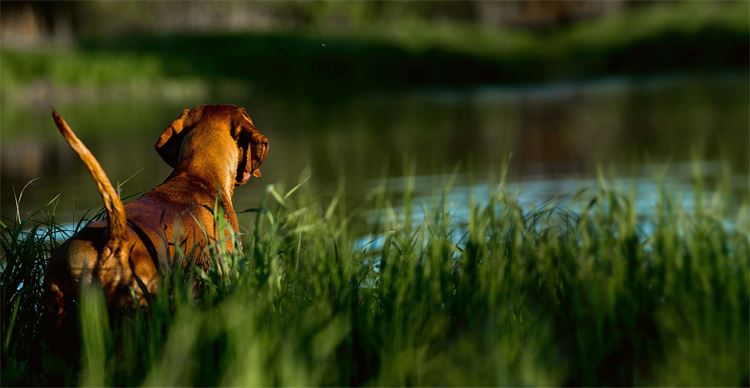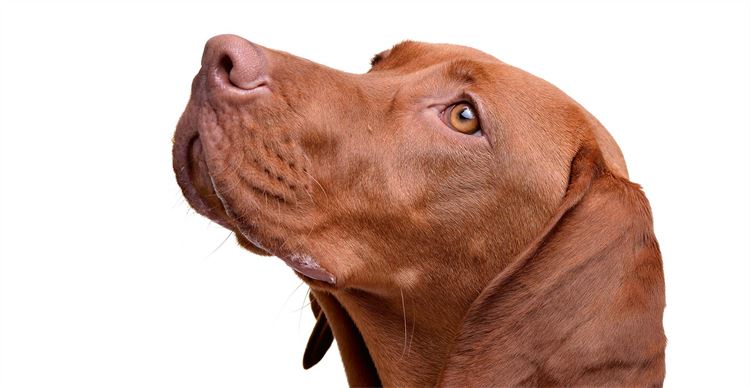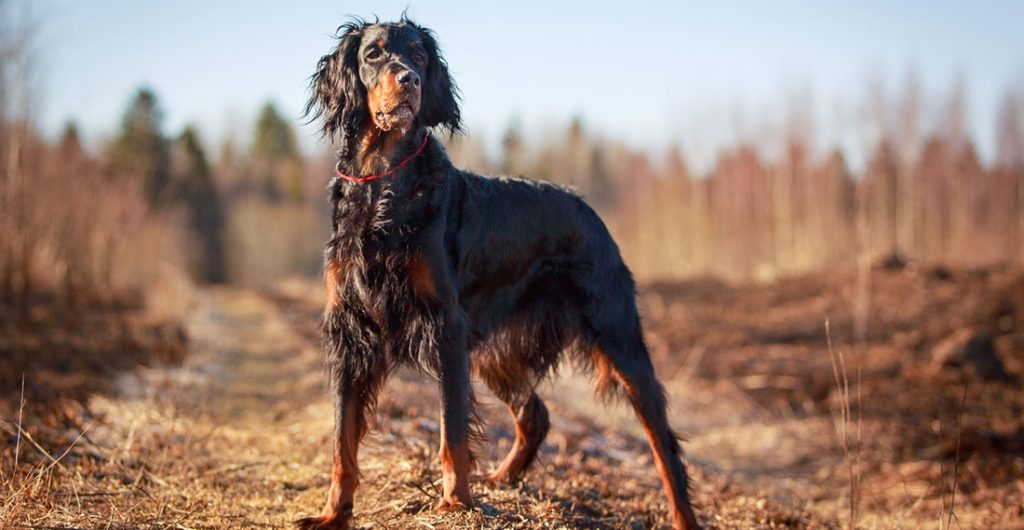A Versatile Aristocrat In The Hungarian Vizsla
Patrice Fellows takes a closer look at the popular hunt, point, retrieve breed the Hungarian vizsla.

The Hungarian Vizsla is the most popular hunt, point, retrieve (HPR) dog breed in Britain, and a national treasure in its homeland. With its noble bearing and eye-catching coat, this dog stands out in a crowd. It is lively, intelligent and biddable, both a keen worker and affectionate companion.
However, due to its high energy and somewhat complicated personality, the Hungarian Vizsla requires careful training and management to reach its full potential.
The Hungarian Vizsla’s Medieval Origins
For centuries the Hungarian Vizsla was protected and selectively bred by the nobility in Hungary. The breed became widely known after the Second World War, when some of these sportsmen moved to other countries with their dogs.
It was first introduced to Britain in the 1950s and became firmly established the following decade, when new bloodlines were imported from Hungary. It is supported by two breed clubs in Britain, the first founded in 1968, and several regional gundog societies.
The exact origins of the Hungarian Vizsla are unknown, but it is believed their ancestors were native hunting dogs belonging to Magyar tribes emigrating from Asia to the Carpathian plains in Hungary about 1,000 years ago.
Primitive stone etchings show Magyar tribesmen hunting with falcons and dogs similar in appearance to the Vizsla. The first reference to the breed was in the Illustrated Vienna Chronicle by the Carmelite Friars, a manuscript of early laws from the 1300s. The manuscript contains a chapter about falconry of the nobility with an image of the Vizsla, known as the ‘Yellow Pointer’.
In early years, the dog was used to scent and search birds that were then netted or caught by falcons. With the advent of firearms in the 1700s, its abilities were developed to take on many tasks, such as tracking large wounded game; hunting, pointing and retrieving birds and ground game; and retrieving waterfowl.
The Hungarian Vizsla has been used to hunt partridge, pheasant, grouse, ducks, geese, rabbits, hare, wolf, bear, deer and boar. On land and in water it works with an excellent nose, natural drive, persistence and stamina.
Characteristics of the Hungarian Vizsla
The size of the Hungarian Vizsla variesm but they are usually medium-sized and lean with well-defined muscles; weighing from 20kg–30kg. Males measure up to 64cm at the shoulder and females up to 60cm.
Its distinctive russet-gold, single coat is smooth and shiny, without any woolly undercoat. The breed has a moderately thick tail which is customarily docked by one third if the dog is to work, to avoid injury. It has a lean and noble head, deep chest, long limbs and broad soft ears. Its brown oval eyes harmonise with its coat colour, being just a shade darker and it moves gracefully with a light-footed trot and ground-covering gallop.
Its single coat requires much less grooming compared to long-and wired-haired HPR dog breeds, with weekly just brushing and infrequent baths necessary. Mud and dirt can easily be towelled off and the coat does not have a particularly strong smell, although it does shed.
Due to its single coat the Hungarian Vizsla is not adapted to living outdoors, and it does not withstand cold and harsh conditions as well as its cousin, the Wirehaired Hungarian Vizsla.
The Vizsla Can Be Gentle But Energetic
The Hungarian Viszla’s temperament is greatly influenced by early management in the home. Perhaps unique among the HPR breeds for its history as both a worker and companion, it is strongly attached to its family and should not be left alone for long periods to prevent boredom and destructive behaviour.
Very much ‘in your face’, this dog needs clear guidelines about manners in the house. Separation anxiety can sometimes be an issue, so Vizslas should gradually get used to being away from their owners.
Once an adult, the Hungarian Vizsla requires plenty of exercise with some free running from one to two hours a day, as well as mental stimulation. Even if you don’t plan to work or compete with your dog, early obedience training and some other form of outlet is recommended.
As well as working in the field, Vizslas have excelled in disciplines like agility, the Kennel Club Good Citizen Dog scheme, flyball, search and rescue, and working trials. Hungarian Vizslas are intelligent and biddable dogs, they are eager to learn new activities, but do not react well to harsh corrections or voice. Over-handling or too much correction can lead to stubborn, insecure or clinging behaviour.
While Vizslas are affectionate and loyal to their family, they can sometimes be shy and wary around strangers – both people and dogs. Their intense bond with their owners is underpinned by a protective streak and propensity to bark if they sense danger. Although the breed is not normally aggressive, early socialisation with other dogs and people to build their confidence is essential.
A Healthy Breed
Vizslas are considered a healthy breed, with an average life expectancy of over 12 years. The main health issues being monitored today are cancer, epilepsy, some autoimmune conditions, hip dysplasia and glaucoma.
Since the breed is predisposed to genetic illness, like all purebred dogs, it is essential to buy your puppy from a responsible Hungarian Vizsla breeder that only breeds from physically sound and health tested dogs of good temperament.
Both parents should be scored for hip dysplasia. There are assured breeders listed on the Kennel Club website, as well as a list of recommended breeders on the Hungarian Vizsla Club website, that adhere to their own breed-specific code of conduct.
Hungarian Vizslas Are Versatile In The Field
The Vizsla is an exemplary all-round, general purpose gundog. In Britain they are well adapted to walked-up or rough shooting to hunt game birds like pheasant, partridge, woodcock, snipe and grouse, and sometimes ground game.
As pointing dogs, Hungarian Vizslas work swiftly and cautiously in close contact with game. They do not have the muscularity and pace to range as far as some other dogs, but they still work with high drive, diligence and stamina. They tend to work at close to medium range to their handler, remaining within eyeshot, but they can be trained to range further. They have a superb nose and are considered a gentle-mouthed retriever.
Although the driven shoot is not ideal for Vizslas, with the right management they can become a valuable member of the beating and picking-up team. HPRs are still a minority compared to spaniels and retrievers, so make sure yours is impeccably trained and behaved to overcome any prejudices or uncertainties on the part of the gamekeeper.
Like other HPRs, Vizslas can be trained to work on the extremities of the beating line, in bordering wood or hedgerows. This way they will not hold up the line if they occasionally go on point when finding a bird to flush.
Working as a peg dog will not come naturally to them, as like spaniels they prefer to be part of the action. However, they are well-suited for picking up. Remaining quiet and still during the drive is a good steadiness exercise and they can be sent for some challenging and distant retrieves, as well as sweeping cover after the drive.
Falconry is another natural outlet for the Hungarian Vizsla. This sport requires a lot of commitment and training. The handler, bird of prey and dog all depend on each other.
Competitive In The Ring And Field
HPRs have not been split into working and show/companion lines like some other gundogs, and many breeders campaign their dogs in both the ring and field. Currently, there are three field trial champions in the Hungarian Vizsla breed, and 31 champions with both show and working awards.
There is one dual champion, Bitcon Gold Coast at Northey JW. HPR dual champions serve as a reminder that this ideal is not lost: excellence in both spheres is still attainable. By way of comparison, the last retriever to become a dual champion was a Golden Retriever in 1957.
If you’d like to prepare and train your dog for shows you can find out about ringcraft clubs in your area from the KC website. There are fun companion shows held at charity days and other events, open shows and championship shows, where challenge certificates that count towards titles are awarded.
If you’d like to try out working competitions, there are lots to choose from. Vizslas can participate in working tests for HPR breeds held from March to September. They are divided into three classes: puppy, novice and open. Usually there are four tests on the day: hunting/quartering, seen retrieve, blind retrieve and water. To prepare your dog for these competitions it’s best to go to a HPR specific trainer or training group.
Spring pointing events are held from March to May or June. These tests are intended for young dogs to get their first experience in the field and improve pointing and quartering skills. They are set on new crops just high enough to hold birds, which are found and pointed but not shot. Grouse pointing events are run along the same lines.
HPR field trials, the next step up, are intended for dedicated handlers who have trained their dogs to a high standard. Historically, gundog field trials were organised to select breeding stock from the season’s best workers, and today professionals compete alongside amateur dog owners. They are organised by breed and gundog clubs as novice, all-aged and open stakes.
The trial is run like a rough shooting day and limited to 12 dogs, who run singly for about 10 minutes in front of two judges accompanied by up to four Guns. The dogs must hunt, point and flush game when directed, be steady to shot and fall, and retrieve to hand. If not eliminated, each dog will be run twice and then complete a final retrieve out of water.
Is This Shooting Dog For You?
This fascinating Hungarian Vizsla breed has quickly grown in popularity recent years; the latest Kennel Club figures show 2,756 registrations, with the next HPR breed (the German shorthaired pointer) trailing behind at 1,646. Its good looks, athleticism and lively, sometimes whimsical, character appeal to many.
But the Vizsla should not be chosen for its aesthetic qualities alone. This breed is not for the first-time dog owner, and does not suit everyone. You must understand its complicated nature, and work with patience and kindness to bring the best out of it.
As the late breeder Gay Gottlieb wrote in her popular breed book, “For those who have been able to understand and enjoy all his ways, he can be the most affectionate, lively and fascinating of companions.”
The Dog Of A Lifetime – Dual Champion Bitcon Gold Coast At Northey Jw
Christine and Andrew McDonald spent 25 years as devoted spaniel owners before they acquired their first Vizsla. After she had been hired as gundog correspondent for Our Dogs newspaper, she came across a Hungarian Vizsla she liked so much that she decided to buy one of his pups: “He was inspirational in his correctness and grace of movement, but to me it was his biddability combined with his aesthetic beauty that re-kindled my desire to have a vizsla.”
Coast joined their pack of spaniels at Northey Kennels, and he soon showed his worth as a working dog: “At four months he was obedient and good at retrieves, including game.” He was allowed to work at their local shoot on the outside of the beating line, so if he went on point he wouldn’t hold up the other dogs.
His show career ‘went off with a bang’, and after obtaining his Show Gundog Working Certificate and three Challenge Certificates, he became a full champion at two years. Andrew then learned everything he could about HPR training. Coast won his second Open field trial stake in 2013, becoming the third field trial champion in the breed and the first dual champion.
After running in the 2013 HPR Championship he was retired from competition. In Christine’s words, “he is the epitome of the multi-purpose dog, able to inter-mingle rough-shooting, picking-up at local shoots, companionship and playing with puppies. But without any of his titles, he is simply a wonderful dog.”
Dog Breed Overview: The Hungarian Vizsla
Group: Hunt, point, retrieve gundog (HPR).
Physical Traits: Eye-catching, short russet-gold coat. Medium-sized, noble head and bearing, deep chest, lean and muscular. Tail docked by a third for working dogs.
Height: Males up to 64cm at shoulder; females up to 60cm.
Weight: From 20kg–30kg.
Character: Very attached to the owner. Lively, intelligent, biddable, gentle and sensitive. Can be wary of strangers. Multi-faceted personality requiring careful training and management, not suited to all owners.
Daily Care: Very energetic, requiring 1–2 hours of daily exercise plus mental stimulation. Minimal grooming necessary. Not well-suited to living outdoors.
Health: Healthy breed with average lifespan over 12 years. Monitored conditions include cancer, epilepsy, hip dysplasia and glaucoma. Parents should be hip-scored.
At Work: Multi-purpose all-rounder that works with drive, diligence and stamina. Can track large game; hunt, flush and retrieve birds and ground game; retrieve wildfowl; hunt with falcons. Works well on land and in water; ideal on upland terrain and grouse moors.
Other Pursuits: Companion, open and championship shows. HPR working tests, spring and grouse pointing events, HPR field trials. Canine activities like agility, KC Good Citizen Dog scheme, search and rescue, working trials.
Learning More About This Breed
Our knowledge always comes from reputable resources, whether these are highly acclaimed books and certified websites. If you would like to learn more about this fantastic bleed of shooting dogs, below you will find some of our favourite resources from websites to books:
- vizsla.org.uk
- hungarianvizslaclub.org.uk
- hprga.co.uk
- thekennelclub.co.uk
- The Hungarian Vizsla (Gay Gottlieb),
- Hunt, Point, Retrieve Dogs for Work and Showing (N.C. Dear),
- HPR License to Hunt (Phil Pearson)
Related Articles
Get the latest news delivered direct to your door
Subscribe to Gundog Journal
Unlock the full potential of your working dog with a subscription to Gundog Journal, the UK’s only dedicated magazine for gundog enthusiasts. Published bi-monthly, this authoritative resource delivers expert training advice, in-depth interviews with top trainers and veterinary guidance to help you nurture a stronger bond with your dog.
With stunning photography and thought-provoking content, Gundog Journal is your essential guide to understanding, training and celebrating your working dog.
Save 10% on shop price when you subscribe, with a choice of packages that work for you. Choose from Print & Digital or Digital only with each journal delivered directly to your door or via the app every other month, plus access to past issues with the digital back issue library.










